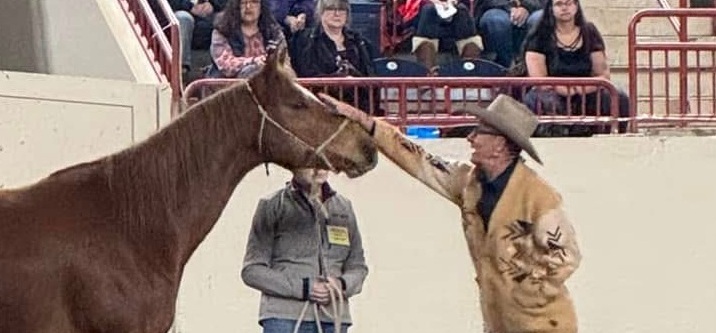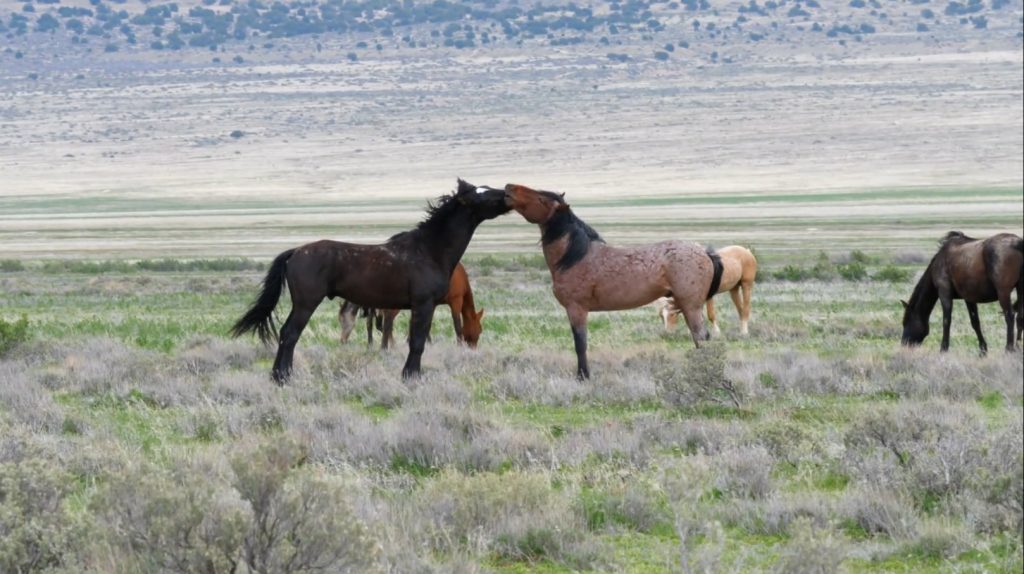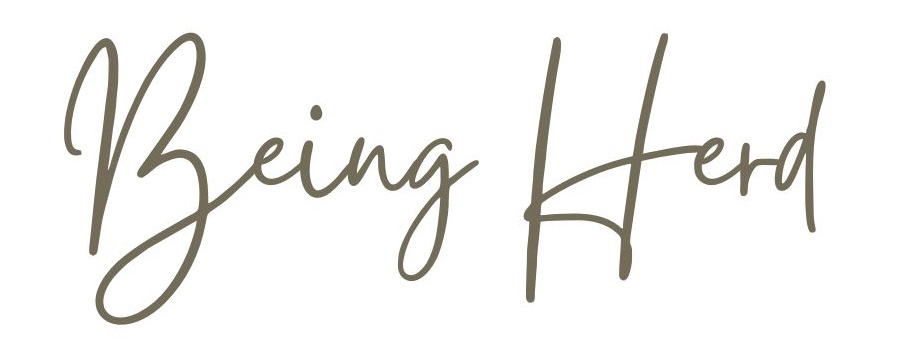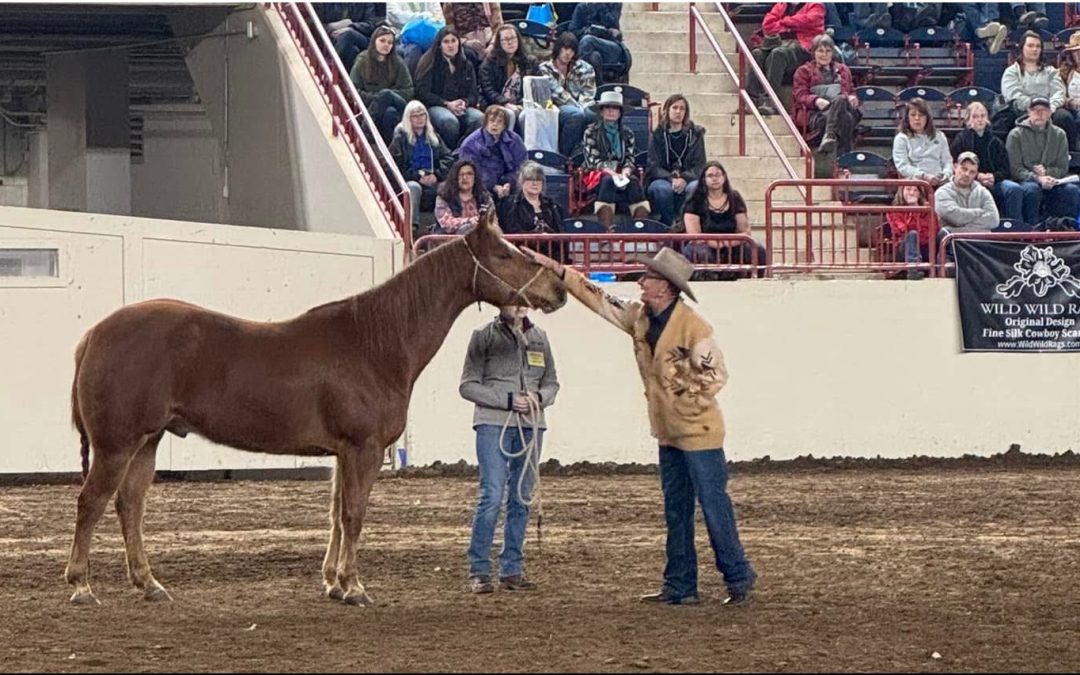1. The Paradox: When Words Sound Gentle but Actions Say Otherwise
Warwick Schiller has built a wide audience by repositioning himself—from a former natural horsemanship trainer to someone now often associated with softness, presence, and consent in horse training. His shift in language over the past years has resonated with many people looking for something more conscious in the way they relate to their horses. And truthfully, some of what he says sounds aligned with the kind of respectful leadership we all want to see.
But here’s the issue: language isn’t enough.
When words about gentleness aren’t grounded in a true understanding of horse behavior, they risk becoming performance. A surface-level shift that may sound convincing—but not to the horses. And not to those of us who’ve spent years listening to what horses actually say through their bodies, especially in the wild.
In his recent post, framed around the idea of “inappropriate touching,” reveals just how easily we can misinterpret—or worse, override—the very communication we claim to honor. His words suggested restraint, patience, and mutual respect. But the photo accompanying them? It told a very different story.
And this gap between narrative and action isn’t just personal. It speaks to a much larger problem in the horse world—a growing movement toward gentleness that risks becoming aesthetic rather than authentic.
2. The Photo That Says It All: What’s Really Happening Here?
At first glance, the image accompanying Warwick’s post might seem harmless. A horse stands on a lead rope in a public arena, flanked by its handler and Warwick himself, who is mid-demonstration in front of a crowd. He’s reaching toward the horse’s face, hand extended. The caption? A lesson in consent. A warning against “inappropriate touching.” A declaration that the horse, in raising its head, is saying, “Not there, please—on my muzzle.”
But let’s pause and really look at what’s happening.

The horse’s head is elevated—not in curiosity, but in avoidance. The ears are neutral, slightly withdrawn, the neck stiff, the mouth tight. The overall posture isn’t one of connection, but of compliance. This is not a horse actively engaging in mutual contact; it’s a horse responding—possibly shutting down—in a situation where it can’t choose much of anything at all.
And the most glaring contradiction? Despite preaching about respecting the horse’s “no,” he touches the horse anyway. On the face. In front of an audience. As if to prove a point by ignoring the very principle he just explained.
This isn’t subtle nuance. It’s a fundamental misunderstanding of equine communication. One that gets hidden under polished words, while the horse’s signals go unseen.
3. Real Horse Communication: What a Greeting Actually Looks Like
When horses meet in the wild, things look very different from what we often try to recreate in human-led interactions.
Greetings aren’t casual or constant. They’re rare, brief, and typically occur nose-to-nose. They don’t get repeated in short intervals—and they almost never involve repeated face-to-face nuzzling like we might imagine from Warwick’s description.
In natural settings, horses greet each other primarily in two contexts:
- Occasionally within their herd or
- Two herd stallions outside their herd
That’s it.
A mare doesn’t greet her best friend every day. A young stallion doesn’t repeatedly muzzle another just to say, ‘hey, give me attention.’ And yes, he actually does this often, but it’s not a greeting—it’s a contact request, a clear invitation to engage—in play.
The horse in this photo? More likely showing a coping behavior—a way to manage stress in a situation where saying ‘no’ isn’t really an option.
The repeated “muzzle touches” Warwick describes? That’s not greeting. It’s not even necessarily connection. If anything, it could signal confusion, sensory seeking, or an attempt to manage pressure in a high-stimulus environment. And when the horse does it “over and over,” that’s the clearest sign that we’re no longer witnessing a greeting at all.
In the wild, within a herd a greeting happens occasionally. It is brief, clear, and always mutual signal. When we impose our own narratives—like assuming a horse wants to connect simply because it doesn’t resist—we stop listening. And once we stop listening, we’re no longer communicating. We’re just performing.
4. Touching Without Consent: The Core Contradiction
One of Warwick’s key takeaways in his post is that we shouldn’t touch a horse unless they touch us first. It sounds thoughtful. Respectful, even. But then, in the same moment that he’s advocating for this boundary—he breaks it.
The contradiction isn’t subtle: in the photo, his hand is mid-air, reaching for the horse’s face. And worse, this moment is used to illustrate his point—deliberately touching the horse in a place he assumes it won’t like, in front of a crowd, to show what not to do.
Let’s pause here: Why is it necessary to prove that a horse doesn’t enjoy being touched in a certain way by doing it anyway?
When we talk about “consent,” it isn’t just about physical contact—it’s about whether the horse is in a position to say no. And a horse, alone in an arena, on a lead rope, surrounded by noise and unfamiliar people, doesn’t have much room for refusal. They might move their head or blink or freeze—but those signals are often subtle and easily dismissed.

True consent comes from a place of freedom. A place where the horse could walk away, lower their head, or engage naturally—without pressure. If we’re testing consent while simultaneously removing the option to withdraw it, we’re not really testing anything at all.
In the end, this wasn’t a lesson in communication—it was a lesson in control, dressed up as awareness. And the horse? The horse just had to tolerate it.
5. High Stress, Low Awareness: The Problem with Arena Demonstrations
Let’s talk about context.
The horse in Warwick’s photo is in a public arena—alone, haltered, surrounded by people, and managed by handlers he may not know. If this was truly a horse with a history of biting, as stated, then we’re already looking at a horse under stress. And now, we’ve added bright lights, an audience, unfamiliar smells, and a new handler who is engaging in a very controlled, very staged form of interaction.
This is not the environment for observing natural horse behavior. Not even close.
In the wild—or even in a well-adjusted domestic setting—greetings, play invitations, or communication between horses happen freely, without constraint. But in this situation, what Warwick interprets as a “muzzle greeting” could be any number of things:
▪️ A coping mechanism.
▪️ A trained or reinforced behavior.
▪️ Or a subtle displacement of nervous energy.
And yet, rather than acknowledging this pressure, Warwick uses the horse’s responses to support a prewritten narrative. He talks about “matching the energy” and “greeting like the horse does,” while standing in a space where no true communication is even possible.
A truly gentle approach means knowing when not to teach, especially when the horse’s signals are muted by the environment.
Because if we strip away the horse’s freedom, then analyze its reactions—we’re no longer learning from the horse. We’re just using it as a prop.
6. Anthropomorphism & “Attention-Seeking”: A Human Story, Not a Horse’s
One of the most telling lines in Warwick’s post is when he interprets the horse’s repeated muzzle contact as “Hey, pay attention,” followed later by a friendlier, “Hey, how’s it going.” It sounds charming. Relatable. Human.
But that’s just the problem.
Horses don’t think like we do. They don’t seek attention in the way children might, or send conversational “vibes” like someone at a cocktail party. Their signals are functional, embodied, and grounded in survival and relationship—not ego or social performance.

When a horse repeatedly reaches out with its muzzle in a situation like this, it’s not making small talk. It may be seeking regulation in a stressful setting. It may be confused. It may be reenacting a learned pattern that once led to release or praise. Or, in other cases, it could be inviting movement or play—but even then, that’s situational and specific.
To label these nuanced actions with casual human interpretations flattens the horse’s language into something convenient for us. Something that feels good to believe.
But when we do that, we risk missing what’s actually happening—especially if the horse is simply trying to cope, not connect.
If we truly want to meet our horses where they are, we have to start by giving up the stories that make us feel comfortable—and start listening to the truth in their bodies.
7. What Real Connection Looks Like—And What I’d Do Instead
So let’s ask the real question: What would connection have looked like in this situation?
First, I wouldn’t have brought a horse into a show arena unless I knew them deeply—unless we already had a bond, and I was sure the setting wouldn’t overwhelm or mute their ability to say “yes” or “no.” Especially not a horse with so-called “biting issues.” That label alone tells me this is a horse who has learned that subtle communication doesn’t work.
If I were helping someone with a horse like this, I’d start with observation, not action. I’d ask the owner when the behavior shows up, where it happens, and whether the horse is in a confined space like a stall or paddock when it occurs. I’d want video if possible—because context matters.
I’d then assess the signals: Is this truly a greeting? A request for space? A displaced behavior tied to frustration or anxiety? Or is it an invitation to interact, like a playful young gelding might offer if he has the freedom and space to move?
And most importantly, I’d help the human understand: Does your horse see you as part of their herd yet? Because only then can contact—mutual, voluntary contact—begin to feel safe.

If yes, then sure, you might be able to initiate touch, and it will be received. If not, then your horse might need time to know that communication is not only allowed—but honored.
And that doesn’t happen in an arena. It happens in stillness. In space. In the quiet trust that builds, moment by moment, without pressure or performance.
8. Final Thoughts: Let’s Stop Rewarding the Talk Without the Walk
It’s easy to say the right things.
“Wait for consent.”
“Be gentle.”
“Let the horse choose.”
These phrases are everywhere now—and on the surface, that’s a good sign. It shows that the conversation is shifting. That more people are rejecting dominance-based models and starting to explore what a trust-based relationship with horses could actually look like.
But here’s the hard truth: language can evolve faster than understanding. And sometimes, when someone with a big platform adopts a softer vocabulary without truly embodying it, the result is confusion, not clarity.
That’s what I see in posts like this one.
Not malice. Not cruelty.
Just a fundamental disconnect between words and behavior—between what’s being said and what’s actually happening in the horse’s experience.
It’s not enough to “talk the talk” of connection. You have to live it.
You have to know what a “yes” and a “no” look like in your horse’s body—not just guess. You have to stop interpreting stress as affection, compliance as consent, and movement toward you as a sign that your horse is happy to perform.
We owe our horses better than that.
And if you want to learn what real, natural leadership looks like—not just the kind that feels good to us, but the kind horses actually respond to—I invite you to go deeper with me.
📹 Watch my free video series on wild horse leadership
📥 Download my guide: 5 Steps to Earn Your Horse’s Trust—Insights from Wild Stallions
🌱 Join the Being Herd community, where we practice trust, clarity, and true connection—one honest moment at a time.
Because your horse already knows the difference.
Now it’s time you do, too.


Recent Comments